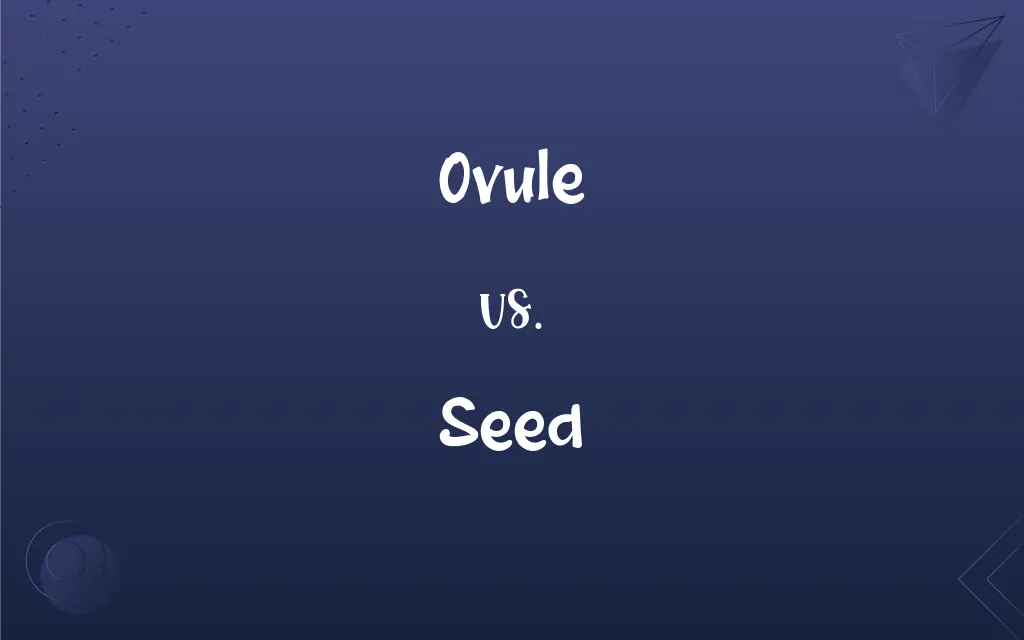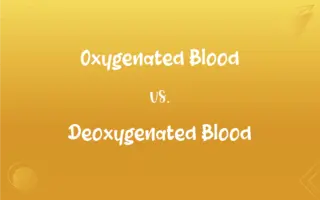Ovule vs. Seed: What's the Difference?
Edited by Aimie Carlson || By Harlon Moss || Updated on October 27, 2023
An ovule is a part of the flower that develops into a seed after fertilization, while a seed is a matured ovule containing an embryo.

Key Differences
The ovule is a structure present within flowering plants, specifically inside the ovary of the flower. It's a critical component because, when fertilized, it transforms into a seed. On the other hand, a seed represents the matured ovule, post-fertilization, containing an embryonic plant.
Ovules play an essential role in plant reproduction, waiting to be fertilized by pollen to start the process of seed formation. In contrast, the seed carries the genetic material from both parent plants and holds the potential to grow into a new plant.
Every ovule has the potential to develop into a seed, but not all ovules get fertilized. However, every seed originates from a once-existing ovule, symbolizing successful fertilization and the promise of new plant life.
The primary function of the ovule is to be receptive to pollen, leading to fertilization. The seed, having moved beyond this phase, focuses on dispersal and germination, ensuring the continuation of the plant species.
Both the ovule and the seed are integral to the life cycle of flowering plants. The ovule sets the stage for potential fertilization, while the seed carries forth the legacy, sprouting into a new plant when conditions are favorable.
ADVERTISEMENT
Comparison Chart
Stage in Life Cycle
Pre-fertilization
Post-fertilization
Contains
Genetic material awaiting fertilization
Embryonic plant and stored nutrients
Location
Inside the ovary of the flower
Can be inside a fruit or dispersed in the environment
Function
Awaiting fertilization by pollen
Germination to produce a new plant
Result of
Plant's reproductive structure
Fertilized ovule
ADVERTISEMENT
Ovule and Seed Definitions
Ovule
Ovules contain the genetic material for potential fertilization.
The genetic material within the ovule combines with pollen to create seeds.
Seed
Seeds carry the genetic information from both parent plants.
The seed inherits traits from both its mother and father plants.
Ovule
Ovules are integral to the reproductive cycle of flowering plants.
The process starts with the ovule, leading to the formation of seeds and eventually new plants.
Seed
Seeds can germinate under the right conditions, leading to a new plant.
With water, sunlight, and soil, the seed sprouted into a new sapling.
Ovule
Ovules reside within the protective environment of the ovary.
The ovary safeguards the ovule until fertilization occurs.
Seed
Seeds ensure the continuation and dispersal of plant species.
Birds often eat fruits and disperse the seeds, promoting plant growth in new locations.
Ovule
An ovule is the part of a flower's ovary that can develop into a seed.
Inside the flower, the ovule waits for pollen to achieve fertilization.
Seed
Seeds often have stored nutrients to support the initial growth of the embryo.
The seed provides the necessary nutrients for the young plant until it can photosynthesize on its own.
Ovule
Each ovule represents a potential seed.
Not all ovules get fertilized, but those that do become seeds.
Seed
A seed is a matured ovule that contains an embryonic plant.
From a tiny seed, mighty plants can grow.
Ovule
(Botany) A structure in seed plants that consists of the embryo sac surrounded by the nucellus and one or two integuments and that develops into a seed after it is fertilized.
Seed
A mature plant ovule containing an embryo.
FAQs
Where is the ovule located in a flower?
The ovule is located inside the ovary of the flower.
What happens to the ovule after fertilization?
After fertilization, the ovule develops into a seed.
Why are seeds important?
Seeds ensure the continuation, dispersal, and growth of plant species.
Do all ovules become seeds?
No, only ovules that get fertilized develop into seeds.
What is an ovule in plants?
An ovule is the part of a flower's ovary that can develop into a seed after fertilization.
How does a seed differ from an ovule?
A seed is a matured ovule containing an embryonic plant, formed after fertilization.
Can seeds germinate immediately after formation?
Not always. Some seeds require specific conditions or a dormancy period before germination.
How do seeds spread?
Seeds spread through various means: wind, water, animals, and human activities.
Can seeds survive in harsh conditions?
Many seeds have a protective outer layer that allows them to survive in unfavorable conditions.
Are ovules present in all flowers?
Ovules are present in all female flowers or bisexual flowers that contain both male and female reproductive parts.
What do seeds need to germinate?
Seeds typically require water, oxygen, and the right temperature to germinate.
How do ovules get fertilized?
Ovules get fertilized when pollen from a flower's anther reaches and merges with it.
What determines the number of seeds a plant will produce?
The number of fertilized ovules typically determines the number of seeds.
Can you eat seeds?
Many seeds are edible and nutritious, though not all are suitable for consumption.
What does a seed contain?
A seed contains an embryonic plant and often stored nutrients for initial growth.
Do all plants produce seeds?
No, only flowering and cone-bearing plants produce seeds. Others reproduce via spores.
How long can a seed remain viable?
Depending on the species, some seeds can remain viable for years, while others have a short lifespan.
What's the role of the ovary in relation to the ovule and seed?
The ovary houses the ovule and, after fertilization, develops into a fruit, protecting the seed.
Can a single flower produce multiple seeds?
Yes, a single flower can house multiple ovules, leading to multiple seeds after fertilization.
Why don't all ovules become seeds?
Not all ovules get fertilized by pollen.
About Author
Written by
Harlon MossHarlon is a seasoned quality moderator and accomplished content writer for Difference Wiki. An alumnus of the prestigious University of California, he earned his degree in Computer Science. Leveraging his academic background, Harlon brings a meticulous and informed perspective to his work, ensuring content accuracy and excellence.
Edited by
Aimie CarlsonAimie Carlson, holding a master's degree in English literature, is a fervent English language enthusiast. She lends her writing talents to Difference Wiki, a prominent website that specializes in comparisons, offering readers insightful analyses that both captivate and inform.







































































